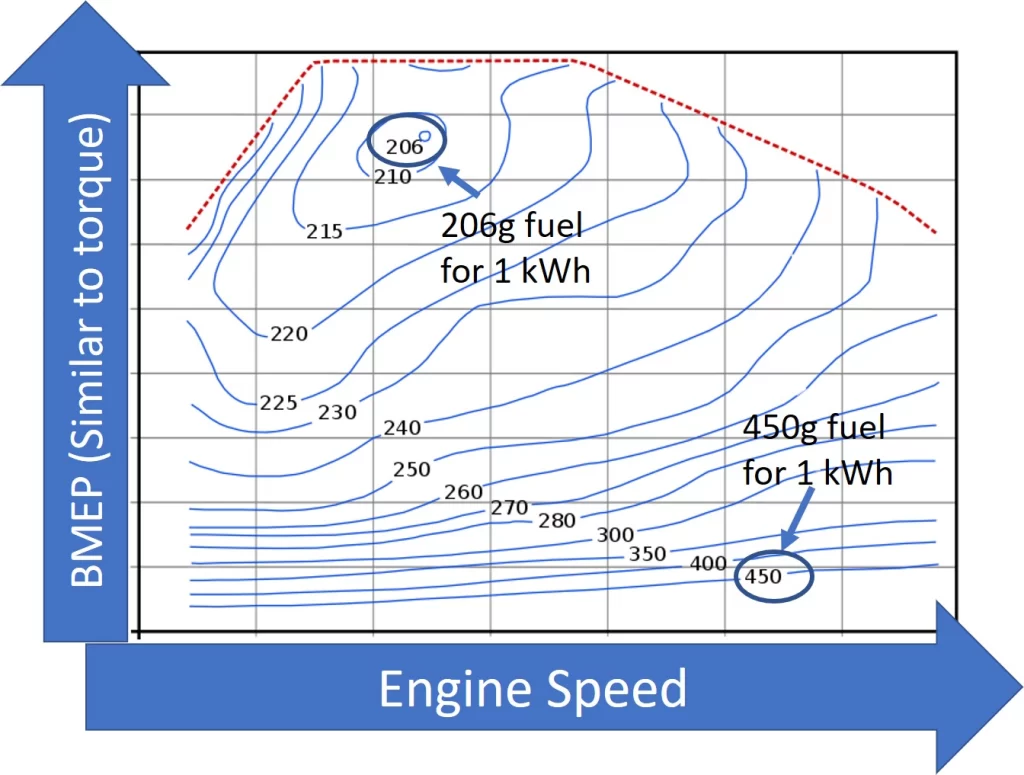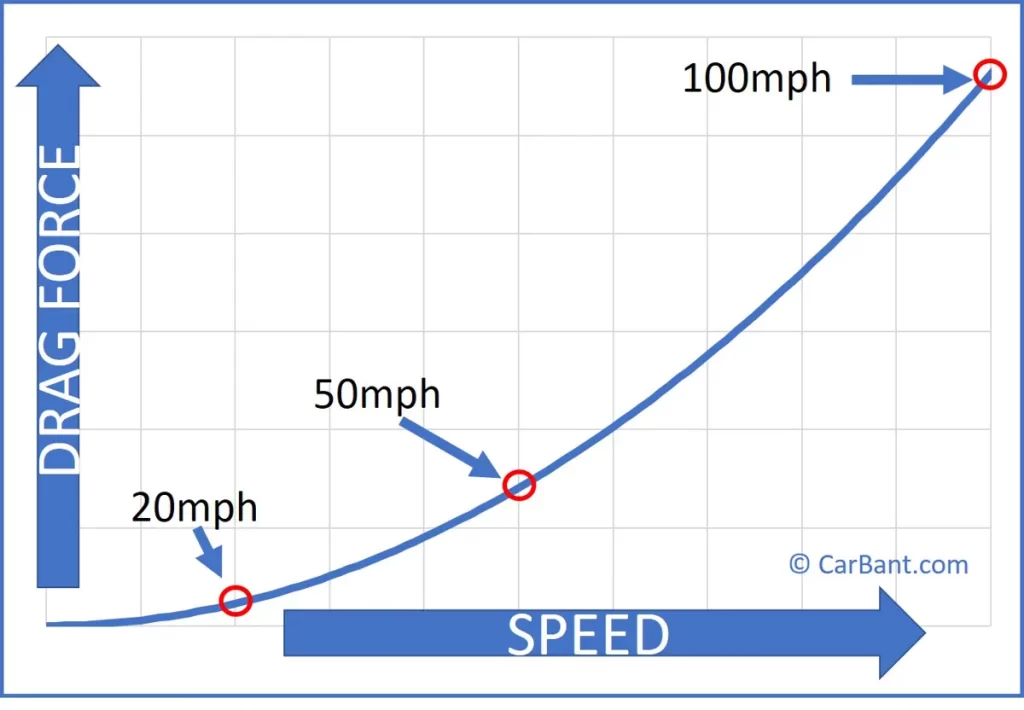Electric car’s are most efficient at slow speeds, ideally around 10mph! (unlike their ICE equivalents). And are way more efficient at all speeds compared to cars with an internal combustion engine.
The slower any vehicle is driving, the less aerodynamic losses. It is this fact, coupled with the absence of any other huge energy losses that makes EVs are so efficient at very low speeds.

This post uses a thought experiment to understand why EVs are most efficient when driving as slowly as 10mph, the new fangled equivalent of miles per gallon (mpg) and some sneaky tips to increase EV range.
Why Are Electric Cars More Efficient at Slow Speeds
What is Efficiency
Efficiency is like filling a glass full of water and then pouring it into another glass. If the process was 100% efficient you wouldn’t ‘lose’ any water during the pouring. Likewise, when you charge or refuel a car, you put energy into it (like filling that first cup) then you drive somewhere and if that process is efficient you don’t ‘lose’ any energy to useless things (eg. heat and noise).
The less efficient a vehicle, the more fuel energy is required to go a certain distance.
Efficiency = [Useful Energy Out] / [Total Energy In]
Cars use energy to move. Electricity is one form of energy, diesel or gasoline is another form of energy.
A Thought Experiment
As an engineer I sometimes use ‘thought experiments’ to help me understand complicated problems. This certainly falls under the umbrella of a complicated problem!
To make heat and noise takes energy. Any time you are making heat or noise you are wasting energy and impacting the efficiency of your journey. Traditional ICE cars make noise and heat when they aren’t even going anywhere, idling in traffic!
Driving slowly, some energy will be used to move the vehicle, but a huge proportion of that will be used to create heat and engine noise. Think ICEs are not that loud? Engineers have spent millions $$ developing the exhaust system to dramatically attenuate (limit) the noise from the exhaust. Don’t believe me? Motorbikes have little exhausts and engines that often produce similar power to big SUVs, motorbikes are not quiet are they!
It’s January here in the UK and it’s freezing (-2°C outside). As you may or may not know, I drive a plugin hybrid (PHEV) and in an effort to save fuel and prevent the engine switching on I tend to drive around with my coat on and the heater off – Engine OFF Driving- Find Out How To Prevent Hybrid Engine Start. At no point in an EV’s journey does anything get warm enough in the powertrain to be used to divert heat into the cabin, EVER! Not to mention that most EVs have some sort of synthesized noise, else they would be essentially silent.
Thought Experiment Visualised
So let’s take a pretty typical example (CAUTION this is overly simplified for demonstration purposes): When fuel is burnt in an engine, for every 70ml used to make loud engine noises and a burning hot engine, a further 25ml is used to drive slowly, the efficiency would be (25/(25+70)) x 100 = 26.3%.
Now lets imagine we are going a little faster (ICE vehicles are most efficient ~50mph). We still put aside 70ml to heat up the engine and make lots of noise but we use a bit more fuel, eg. 40ml to do useful work (travel faster), this increases efficiency to 36.4%, not great but it’s about as good as you get!


An electric vehicle (EV) doesn’t really make much heat or noise, so most of the energy from the battery is used to move the vehicle. Let’s recreate the above graphs for an EV now:

It is clear to see that in the absence of noise and heat, most of the electrical energy stored in the battery is converted to useful energy. The numbers above use a model of EV powertrain being 90% efficiency.
What Happens to Efficiency When Driving Up Hill
When any vehicle travels up a hill, the power required to maintain steady speed increases and is proportional to the gradient.
Data from a paper published by university Minho, Portugal confirms that on the flat an EV uses less than half the power of an equivalent diesel car. However, the gap narrows slightly on a 6% gradient at high speed (eg. 110 kph). This is actually expected behaviour. As we both know, EVs prefer slow speeds and internal combustion engines become more efficient as they approach peak torque – a hill would do this. I’ll put a BSFC graph of an engine below, which demonstrates this principle:

What’s the Most Efficient Electric Car
There are a few things that affect an EV’s efficiency, namely;
- Weight (Lighter cars need less power to accelerate)
- Aerodynamic drag (Smaller ‘sleeker’ cars have less drag)
- Tyres, powertrain motor controller efficiency and calibration
Here’s a Top 10 list, (Source: VCA, WLTP test cycle):
- Fiat 500e (5 miles/kWh)
- Hyundai Ioniq (5 miles/kWh)
- Tesla Model 3 Standard Range Plus (4.4 miles /kWh)
- Hyundai Kona Electric 39 kWh battery (4.3 miles/kWh)
- DS 3 Crossback (4.2 miles/kWh)
- SMART EQ fortwo (4.2 miles/kWh)
- Volkswagen ID.3 (4.1 miles/kWh, WLTP cycle)
- Renault Megane E-Tech (4 miles/kWh)
- Kia Soul EV (4 miles/kWh)
- Citroen C4 (4 miles/kWh)
Electric Vehicle Efficiency – Miles per kWh Explained
Miles per kilowatt-hour (mpkWh or miles/kWh) is a measure of the distance an electric vehicle (EV) can travel on a single charge of its battery, using the energy equivalent of one kilowatt-hour (kWh). It is similar to the more traditional measure of fuel economy for gasoline-powered vehicles, miles per gallon (mpg).
For example, if an EV has a range of 100 miles on a single charge, and the battery has a capacity of 30 kWh, the car would be covering 3.33 miles/kWh (100 miles / 30 kWh).
The main difference between miles/kWh and mpg is that mpg measures the distance a vehicle can travel on a single gallon of gasoline, while miles/kWh measures the distance an EV can travel on a single kWh of electrical energy.
Another difference is that mpg is a measure of fuel efficiency, while miles/kWh is a measure of energy efficiency. Therefore, it’s important to consider the cost of electricity when comparing the cost of driving an EV versus a traditional gasoline vehicle.
Are Electric Car’s Efficient on Long Journeys
The efficiency of an EV on a long journey is still great especially compared to ICE vehicles. As stated in this article already, an internal combustion engine is lucky to return 35% efficiency, conversely expect about 90% efficiency from an EV drivetrain.
As speed increases the aerodynamic wind drag squares:

This effect happens to EVs exactly the same as it does to ICE vehicles. By driving 10mph slower you can significantly improve your vehicle’s miles / kWh metric, in other words, go further on a single charge.
The issue of range anxiety for electric vehicles seems to be receding. The funny thing is, the uptake in EV ownership is growing far quicker than the installation of new charging stations. Clearly, people are getting more used to the new way of refuelling.
EVs can cope well on long journeys, as long as you plan your route to include charging stations and you’re prepared to stop and charge the battery along the way. In reality you would probably not be too bothered about a 30 minute stop every 200miles.
FAQs
What About the CO2 to Produce Electricity?
- Extracting, refining and distributing fossil fuels in Europe is ~92% efficient
- Internal combustion engines get between 25% – 35% efficiency
- On average electricity generation is becoming more renewable but coal fired power plants are only able to get at best 44% efficiency
- Power transmission losses are about 90% efficient
- EV powertrains typically get at or above 90%
In summary, EVs are still significantly lower emitters of CO2 compared to ICE, every year, as renewables become more common that gap widens.
You could install Solar PV cells on your roof and also don’t buy a huge car like a Mercedes EQV 300 which covers a mere 2 miles/kWh!
What’s more important efficiency or cost to charge?
The discussion on efficiency does not necessarily tie in to how much you pay for a trip. As the cost of fuel begins to decline and the cost to charge in public stations can be seriously high, you have to ask the question, is fuel cheaper than electricity? Perhaps a hybrid is actually a sound option after all? Check out this post I wrote – How Much Does it Cost to Charge a Plug in Hybrid
What Other Technology Could be Used to Increase my Range?
Years ago, I worked for Ricardo and they were developing some truck ‘platooning’ technology, to allow trucks to follow very closely behind one another to minimise drag and save fuel.
Interactive mapping, where all the cars report progress as a network to a server which then distributes the best journey to an individual can help route traffic the most efficient way.
Before You Go…
Have you checked out these posts I think you might like?

